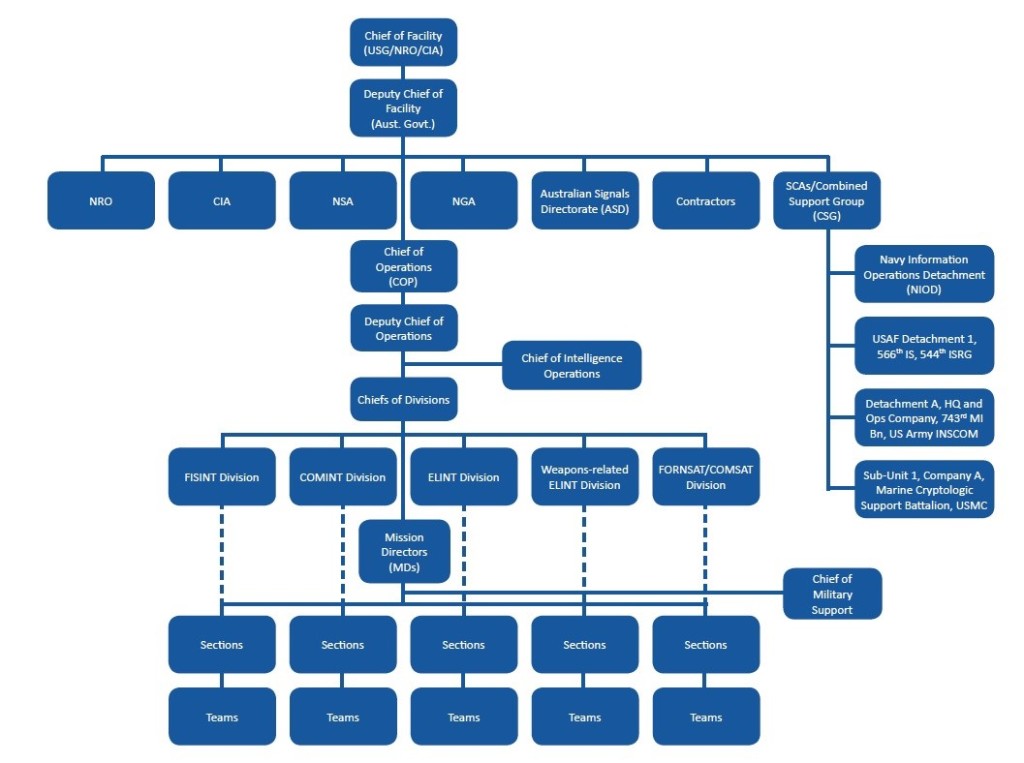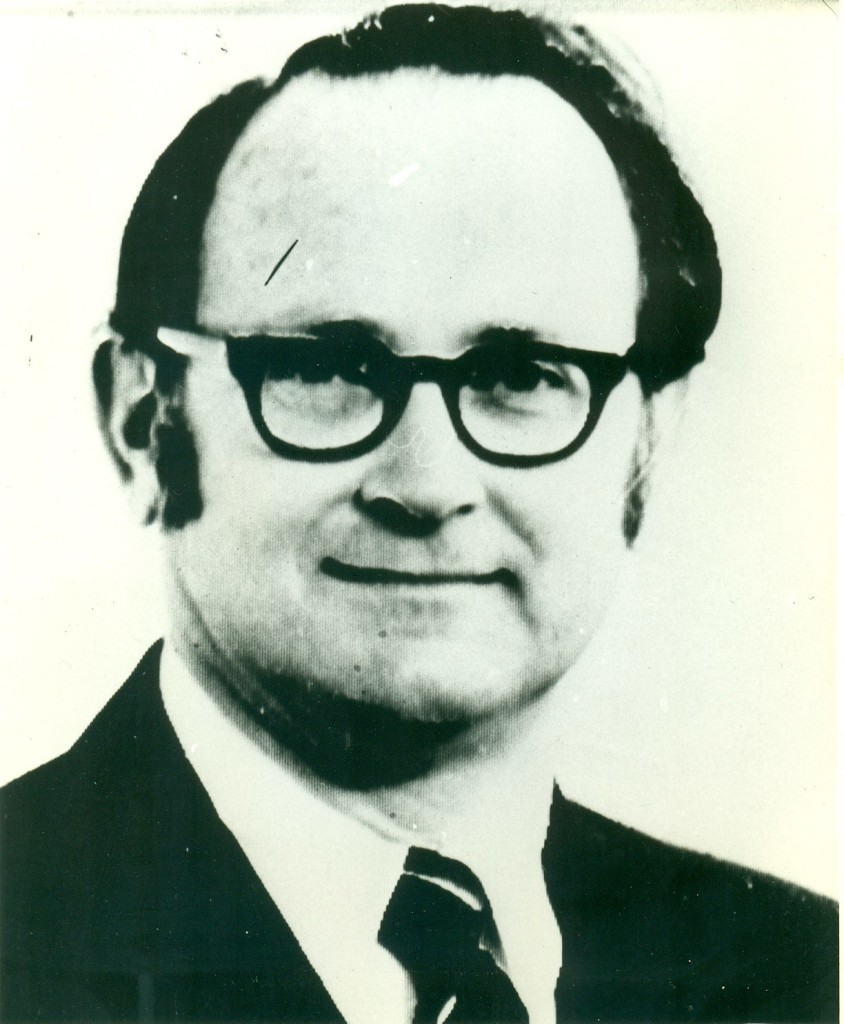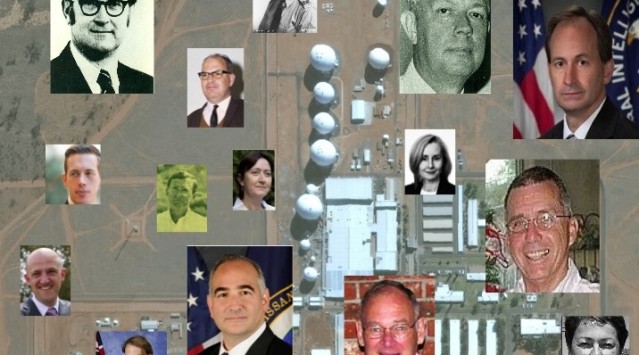by Desmond Ball, Bill Robinson and Richard Tanter
24 November 2015
The full report is available here.
NAPSNet Special Report
I. Introduction
The management of operations at the Pine Gap facility has become increasingly complex as the functions of the station have expanded, the number of agencies involved has grown, and the demands of a wider range of ‘users’ or ‘customers’ for the provision of ‘actionable intelligence’ in near real-time have increased markedly. Operations at Pine Gap are now completely integrated, in terms of American and Australian, civilian and military, and contractor personnel working together in the Operations Room; the organisational structure for managing operations, which embodies concerted collaboration of multiple US agencies, including the National Reconnaissance Office, Central Intelligence Agency, National Security Agency, Service Cryptologic Agencies and the National Geospatial-Intelligence Agency (NGA); and functionally with respect to signals intelligence (SIGINT) collected by the geosynchronous SIGINT satellites controlled by Pine Gap, communications intelligence collected by foreign satellite/communications satellite (FORNSAT/COMSAT) interception systems at Pine Gap, and imagery and geospatial intelligence produced by the NGA, as well as missile launch detection and tracking data.
Conceptualising the extraordinary growth and expansion of operations at Pine Gap is not easy – by the nature of the facility. Externally, it is evident in the increase in size of the two main operations buildings within the high security compound – areas quite distinct from the separate part of the facility that deals with administration matters. The total area of floor space in the Operations Buildings has increased five-fold since 1970 to more than 20,000 m2. If the floor area of the two operations buildings were laid out and joined together, it would cover more than three and a half American football fields. More parochially, though for Australians more meaningfully, the floor area of Pine Gap’s operations complex would more than cover the entire playing field of the Melbourne Cricket Ground, the largest sporting arena in the country.
Authors
Desmond Ball is Emeritus Professor at the Australian National University (ANU). He was a Special Professor at the ANU’s Strategic and Defence Studies Centre from 1987 to 2013, and he served as Head of the Centre from 1984 to 1991.
Bill Robinson writes the blog Lux Ex Umbra, which focuses on Canadian signals intelligence activities. He has been an active student of signals intelligence matters since the mid-1980s, and from 1986 to 2001 was on the staff of the Canadian peace research organization Project Ploughshares.
Richard Tanter is Senior Research Associate at the Nautilus Institute and Honorary Professor in the School of Political and Social Sciences at the University of Melbourne.
The views expressed in this report do not necessarily reflect the official policy or position of the Nautilus Institute. Readers should note that Nautilus seeks a diversity of views and opinions on significant topics in order to identify common ground.
II. Special Report by Desmond Ball, Bill Robinson and Richard Tanter
Management of Operations at Pine Gap
The full report is available here.
Contents
NRO’s ‘fundamental transformation’ in 2006-08 and NRO’s Ground Stations
Chiefs of Facility
Australian Defence Representative
Deputy Chiefs of Facility
The National Security Agency (NSA)
The Combined Support Group (CSG)
Contractors
The Chief of Operations
The Chiefs of Divisions
The Mission Directors (MDs)
Chief of Military Support
The Floor teams
Conclusion
Report
The management of operations at the Pine Gap facility has become increasingly complex as the functions of the station have expanded, the number of agencies involved has grown, and the demands of a wider range of ‘users’ or ‘customers’ for the provision of ‘actionable intelligence’ in near real-time have increased markedly. Operations at Pine Gap are now completely integrated, in terms of American and Australian, civilian and military, and contractor personnel working together in the Operations Room; the organisational structure for managing operations, which embodies concerted collaboration of multiple US agencies, including the National Reconnaissance Office (NRO), Central Intelligence Agency (CIA), National Security Agency (NSA), Service Cryptologic Agencies (SCA[1]s) and the National Geospatial-Intelligence Agency (NGA); and functionally with respect to signals intelligence (SIGINT) collected by the geosynchronous SIGINT satellites controlled by Pine Gap, communications intelligence (COMINT) collected by foreign satellite/communications satellite (FORNSAT/COMSAT) interception systems at Pine Gap, and imagery and geospatial intelligence produced by the NGA, as well as missile launch detection and tracking data. (Figure 1)
Table 1. Operations personnel at Pine Gap, 2015
| US government:
Civilian (NRO, NSA, CIA) |
US government:
Military |
Australian
government |
Contractor | Total |
| 55 | 105 | 50 | 45 | 255 |
| 22% | 41% | 20% | 18% | 100% |
About 255 or so personnel at Pine Gap, or about a third of the total, are directly involved in operations, working in the Operations Room, 24 hours a day, seven days a week – with the other two-thirds concerned with management, operational support, administration, utilities, maintenance, etc., mostly working 9 am to 5 pm jobs, five days a week. (Table 1)
Figure 1. Organisation of operations at Pine Gap

NRO’s ‘fundamental transformation’ in 2006-08 and NRO’s Ground Stations
The fundamental transformation of the NRO in 2006-08 that was directed by Donald Kerr and Scott Large, the NRO Directors in 2005-07 and 2007-09, included giving greater emphasis to ‘the role of our ground systems’.[ii] The Ground Enterprise Directorate (GED) was established in 2008 and given responsibility not merely for management of NRO’s five Mission Ground Stations (MGSs) but for transforming these into multi-source intelligence centres, at which all of the IMINT and SIGINT is integrated or ‘fused’ and made accessible to all NRO users world-wide.
The first Director of the Ground Enterprise Directorate (GED) was Dr Pete Rustan, who subsequently became Director of the Mission Support Directorate (MSD). He was a vigorous proponent of transforming the NRO ‘into a world class provider of information products and services’ and the MGSs into integrated data centres where IMINT and SIGINT is ‘fused’ in a format which provides ready integration of intelligence collected by other air- and ground-based systems, as well as human intelligence (HUMINT).[iii] He was also a key progenitor of the Real-Time Regional Gateway (RTRG) system, used in Iraq and Afghanistan, which fused all data being collected by SIGINT satellites and other airborne and ground-based SIGINT systems, HUMINT, interrogation reports, satellite and drone surveillance images, together with geolocation data, and was accessible to war-fighters in real-time.[iv]
Recent senior NRO executives have acclaimed the ground facilities for their creativity and ‘magic’, and expressed satisfaction at the rate of progress with the transformation of the MGSs, although some have also expressed concern about their vulnerability. In October 2009, NRO Director Bruce Carlson stated that some of the SIGINT satellites were ‘geriatric’ but still functioning (including Orion-1, also called Magnum-1, and Orion-2, which were then operating at 72° East and 90.5° East respectively). He attributed this longevity to ‘the incredible, creative use of our ground systems’, and cited ‘the incredible contractor and NRO team[s] that we have that nurse [those] satellite[s] along and the young people that write software to change [their] functionality and keep [them] going’.[v]
Betty J. Sapp, who became Director of the NRO in July 2012, has said that ‘ground functions are absolutely critical to planning and executing ISR missions, and in processing the data collected from our national satellites’, that ‘the NRO GED team has already made considerable headway in moving us toward a more holistic, “horizontal” ground enterprise’, although more remained to be done, and that ‘the future NRO ground enterprise will enable the delivery of information to our mission partners and users when they need it and where they need it.[vi]
Kristina Harrington, who was appointed Director of the SIGINT Systems Acquisition Directorate in December 2013, has expressed strong concerns about the vulnerability of the associated ground systems. She said in May 2014 that while ‘both satellites and the ground need to be secure from cyber intrusion or supply chain infection’, the ‘more pressing vulnerability’ was on the ground. She said that the ground networks had become ‘increasingly complex and had become a growing target of cyber attacks’.[vii] She said in April 2015 that changes in the ground infrastructures of NRO’s satellite programs were ‘vital’, and argued that ‘Ground is where a lot of the magic occurs, and it is the place where we invest in last. But it’s one of the things that we can make the greatest leaps with’.[viii]
Chiefs of Facility
There have been 16 Chiefs of Facility at Pine Gap since 1967, most, until recent years, senior officers from the Central Intelligence Agency, and more recently from either the CIA or the National Security Agency. All have been civilians.
Table 2. Chiefs of Facility,
Joint Defence Facility Pine Gap
| Richard Lee Stallings | 1967 – 9.12.1968 |
| Harry E. Fitzwater | 1968-73 |
| Lou Bonham | 1974-76 |
| Harrison (Hy) Markham | 1976-79 |
| Richard Krueger | 1979-81 |
| William Reller | 1981-85 |
| Glenn Kerr | 1985-89 |
| Donald Kingsley | 1989-92 |
| James Mathews | 1992-95 |
| Stephen Provines | 1995-98 |
| Barbara Ely | 1999- ? |
| ? | ? – ? |
| Kevin Keating | 2005-08 |
| Frank Calvelli | 6.2008 – ? |
| Michael Bartholomew | 6.2010 – 6.2013 |
| Tim Howell | 06.2013 – present |
The first US Chief of Facility at Pine Gap was Richard Lee Stallings, a senior officer in the CIA’s Office of Electronic Intelligence, who arrived in Canberra in October 1966 and moved to Alice Springs in January of the following year. Stallings had entered the CIA after serving in the US Navy in both the Second World War and the Korean War, rising to lieutenant commander in naval intelligence.[ix] In the Office of ELINT (OEL) Stallings had previously been stationed in West Germany at the I.G. Farben complex in Frankfurt, the European centre of US armed forces, where he had been responsible for management of the OEL SIGINT stations in West Germany and coordination of CIA’s SIGINT operations in West Germany with those of both the National Security Agency and the West German Federal Intelligence Service (BND). Stallings remained in Alice Springs until 9 December 1968, by which time initial construction of the facility was complete, and the facility was nearly ready to begin operations.[x]
Figure 2. Richard Lee Stallings, Chief of Facility 1967-68

The remainder of this Special Report is available in the full PDF version here.
III. References
[1] See also Desmond Ball, Bill Robinson and Richard Tanter, The militarisation of Pine Gap: Organisations and Personnel, Nautilus Institute, Special Report, 14 August 2015, at https://nautilus.org/wp-content/uploads/2015/08/The-militarisation-of-Pine-Gap.pdf.
[ii] Scott Large, ‘Statement for the Record Before the House Armed Services Committee Subcommittee on Strategic Forces Joint Hearing: Fiscal Defense Authorization Act Budget Request and Status for Space Activities’, 5 March 2008, at http://www.nro.gov/news/testimony/2008/2008-01.pdf; and Desmond Ball, Bill Robinson and Richard Tanter, The Higher Management of Pine Gap, Nautilus Institute, Special Report, 18 August 2015, at https://nautilus.org/wp-content/uploads/2015/08/The-Higher-Management-of-Pine-Gap.pdf.
[iii] Pete Rustan, ‘Building an Integrated Intelligence Network: Challenges and Opportunities’, High Frontier: The Journal for Space & Missile Professionals, (Vol. 4, No. 4), August 2008, pp. 10-14, at http://www.afspc.af.mil/shared/media/document/AFD-080826-020.pdf.
[iv] Ben Iannotta, ‘Change Agent’, Defense News, 8 October 2010, at http://archive.defensenews.com/article/20101008/C4ISR01/10080311/Change-agent; and Shane Harris, @War: The Rise of the Military-Internet Complex, (Eamon Dolan Books, New York, 2014), pp. 33-35.
[v] General Bruce Carlson, ‘GEOINT Symposium, October 21, 2009, San Antonio, Texas’, at http://www.nro.gov/news/speeches/2009/2009-03.pdf; and Desmond Ball, Bill Robinson and Richard Tanter, The SIGINT Satellites of Pine Gap: Conception, Development and in Orbit, Nautilus Institute, Special Reports, 15 October 2015, at https://nautilus.org/wp-content/uploads/2015/10/PG-SIGINT-Satellites.pdf.
[vi] ‘Q&A: Betty J. Sapp’, Geospatial Intelligence Forum, (Vol. 11, No. 3), 28 March 2013, at http://www.kmimediagroup.com/geospatial-intelligence-forum/magazines/1485-gif-2013-volume-11-issue-3-april-alt/6917-qaa-betty-j-sapp.
[vii] Colin Clark, ‘Adversaries Outpace US in Cyber War; Acquisition Still Too Slow’, Breaking Defense, 19 May 2014, at http://breakingdefense.com/2014/05/adversaries-outpace-us-in-cyber-war-acquisition-still-too-slow/; and Andrea Shalal, ‘Military Acquisition Rules Hamper U.S. Ability to Counter Cyber Threats’, Reuters, 19 May 2014, at http://www.reuters.com/article/2014/05/20/us-cybercrime-usa-military-idUSBREA4J03L20140520.
[viii] Harrison Donnelly, ‘Peering Into the Satellite Future’, Geospatial Intelligence Forum, 7 April 2015, at http://www.kmimediagroup.com/gif/articles/424-articles-gif/peering-into-the-satellite-future.
[ix] ‘Stallings, Richard’, Obituaries, Baltimore Sun, 21 February 2004, at http://articles.baltimoresun.com/2004-02-21/news/0402231526_1_annapolis-grandchildren-stallings.
[x] Desmond Ball, Pine Gap: Australia and the US Geostationary Signals Intelligence Satellite Program, (Allen & Unwin, Sydney, 1988, p. 57; and Jeffrey Richelson, The Wizards of Langley: Inside the CIA’s Directorate of Science and Technology, (Boulder: Westview Press, 2002), p. 156.
Nautilus invites your responses
The Nautilus Peace and Security Network invites your responses to this report. Please send your response to: nautilus@nautilus.org.
The views expressed in this report do not necessarily reflect the official policy or position of the Nautilus Institute. Readers should note that Nautilus seeks a diversity of views and opinions on significant topics in order to identify common ground.


